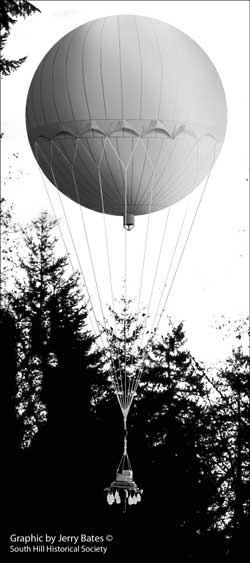Recalling The Bombing of South Hill
by Carl Vest

The South Hill Historical Society asks that the residents of South Hill pause a moment during the month of March and think about something that happened 71 years ago, near the end of World War II. South Hill, like many other communities on the west coast during late 1944 and early 1945, was the target of a Japanese bombing campaign — experiencing two hits. This initiative by the Japanese is not as well-known as many other war-time battles because of government secrecy at the time, aimed at keeping a hostile adversary unaware of its successes.
This was the so-called balloon bomb scheme, or project Fu-Go as the Japanese called it. It was started in 1944. Paper balloons carrying bombs were launched from the main island (Honshu, Ibaraki Prefecture, near Tokyo) and were carried by the jet stream to the North American continent (first sendoff was November 3, 1944, at 5:00 a.m.). It took about three days from launch to impact. By using a system of timers and switches targets were hit all over the western US and Canada. However, it was not until March 1945 that bombs fell on South Hill.
There are two known impact sites on South Hill. One was on the Massie farm, near present day Pope Elementary School. It landed on March 1, 1945. This package did not explode and Mr. Massie found it lodged in a tree. He pulled the balloon down, cut it up and gave scraps to his children for souvenirs. Mr. Massey was fortunate the bomb did not detonate. The only known causalities from the entire campaign happened in Oregon when another group pulled a balloon from a tree and its payload exploded killing several people. Before his untimely death his Mr. Massie’s son brought his fraction of the keepsake to a meeting of the South Hill Historical Society. We all enjoyed touching it. You will not find this particular incident in the official records of the bombing campaign kept by the US government. But it did happen, as there is evidence. Probably, since there was no explosion, it was not reported.
The second one landed just off present-day 94th Avenue, near the present-day location of the Mormon Church. This bomb exploded. It happened on March 5, 1945. There were no injuries. People still living in the neighborhood remember the incident. Joan (Park) Vosler is one. She recalls that the Army sent soldiers from Fort Lewis to secure the area. The troops combed the neighborhood for fragments, lining up shoulder to shoulder and moving over the impact site. She also remembers that her brother tried to get past barriers to the plot and got in trouble for his efforts. So far as is known there are no surviving pieces of this bomb in either private or government hands.
The Fu-Go program was terminated by the Japanese Army in mid-April, 1945. Paper for manufacturing the balloons was in short supply and it was becoming almost impossible to produce enough hydrogen to inflate the balloons.
Carl Vest, PhD, is a founding member and Research Director for the South Hill Historical Society.